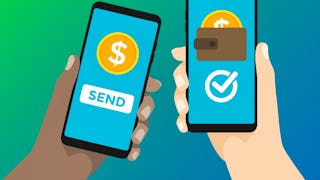The FinTech revolution is rapidly transforming the financial industry. The use of digital technologies is the norm, and together with regulatory and market changes it is creating a revolution. After completion of the module, you'll be able to: describe the changes that influence the financial sector, understand the complexity of the payment infrastructure, identify and explain the key payment instruments and how they function, understand the types of money that exits, and recognize changes in the regulatory frameworks and how they inhibit or promote innovation.



FinTech and the Transformation in Financial Services
This course is part of Digital Transformation in Financial Services Specialization


Instructors: Jonas Hedman
36,670 already enrolled
Included with
(1,176 reviews)
Skills you'll gain
Details to know

Add to your LinkedIn profile
23 assignments
See how employees at top companies are mastering in-demand skills

Build your subject-matter expertise
- Learn new concepts from industry experts
- Gain a foundational understanding of a subject or tool
- Develop job-relevant skills with hands-on projects
- Earn a shareable career certificate

There are 5 modules in this course
The FinTech revolution is rapidly transforming the financial industry. The use of digital technologies is the norm, and together with regulatory and market changes it is creating a revolution. To begin, we recommend taking a few minutes to explore the course site. A good place to start is the navigation bar on the left. Click 'Course Content' to see what material we will cover each week, as well preview the assignments you will need to complete. Click 'Discussions' to see forums where you can discuss the course material with fellow students taking the class. Be sure to introduce yourself to everyone in the 'Meet and Greet' forum! This course should take four weeks to complete. You can check out the recommended course schedule below to see a quick overview of the lessons and assignments you will complete each week. After completion of the course, you'll be able to: describe the changes that influence the financial sector, understand the complexity of the payment infrastructure, identify and explain the key payment instruments and how they function, understand the types of money that exits, and recognize changes in the regulatory frameworks and how they inhibit or promote innovation.
What's included
1 video1 reading1 discussion prompt
In this module, we begin exploring FinTech. We start off by get to know Fintech, by looking into six different FinTech domains, followed by FinTech as an area of investments. Then we dig into the technologies of FinTech, before we look at the regulatory changes that transforms the industry. After completion of the module, you will be able to: summarize the domains of FinTech; describe the FinTech market and make arguments for what the sector is emerging; outline the Financial technologies and how the are transforming the market; give examples of how regulations influence the FinTech market
What's included
5 videos13 readings8 assignments1 discussion prompt
At the heart of the Fintech revolution you will find money and payments. It makes the world go around. In this module, we will learn about money and its history, difference between central bank money and bank money, different payment instruments, and finally how payment instruments are used in contemporary payment methods.
What's included
5 videos12 readings5 assignments2 discussion prompts
Money has several roles, including a medium of exchange, i.e. as a payment. In this module, we focus on the complex digital platforms or eco-systems that surrounds payments. We this from four different perspectives or level of analysis, including bank level, national level, and cross border level. However, first we shall look into the payment process.
What's included
5 videos6 readings4 assignments
The digital transformation is radically transforming the financial services as we used to know them and new areas and domains emerge. In this module, we are focusing on three areas. First, we look at P2P lending, then crowdfunding, before we conclude with open banking.
What's included
3 videos8 readings6 assignments1 discussion prompt
Earn a career certificate
Add this credential to your LinkedIn profile, resume, or CV. Share it on social media and in your performance review.
Instructors


Offered by
Explore more from Leadership and Management
 Status: Free Trial
Status: Free TrialCopenhagen Business School
 Status: Free Trial
Status: Free TrialUniversity of Pennsylvania
 Status: Free Trial
Status: Free Trial Status: Free Trial
Status: Free TrialCopenhagen Business School
Why people choose Coursera for their career




Learner reviews
1,176 reviews
- 5 stars
54.66%
- 4 stars
26.99%
- 3 stars
10.86%
- 2 stars
4.32%
- 1 star
3.14%
Showing 3 of 1176
Reviewed on Mar 14, 2019
course has good content with a top view of what's currently happening. Final evaluation (Week 4) solutions and explanations are required.
Reviewed on Apr 25, 2020
Content is great, its for everyone who wants to grasp knowledge in fintech area. This is the course you can go for it and transform and implement by learning this course.
Reviewed on May 16, 2018
The course gave a great insight on importance and utility of Technology in Financial Services and how FinTech is the future for all.

Open new doors with Coursera Plus
Unlimited access to 10,000+ world-class courses, hands-on projects, and job-ready certificate programs - all included in your subscription
Advance your career with an online degree
Earn a degree from world-class universities - 100% online
Join over 3,400 global companies that choose Coursera for Business
Upskill your employees to excel in the digital economy
Frequently asked questions
To access the course materials, assignments and to earn a Certificate, you will need to purchase the Certificate experience when you enroll in a course. You can try a Free Trial instead, or apply for Financial Aid. The course may offer 'Full Course, No Certificate' instead. This option lets you see all course materials, submit required assessments, and get a final grade. This also means that you will not be able to purchase a Certificate experience.
When you enroll in the course, you get access to all of the courses in the Specialization, and you earn a certificate when you complete the work. Your electronic Certificate will be added to your Accomplishments page - from there, you can print your Certificate or add it to your LinkedIn profile.
Yes. In select learning programs, you can apply for financial aid or a scholarship if you can’t afford the enrollment fee. If fin aid or scholarship is available for your learning program selection, you’ll find a link to apply on the description page.
More questions
Financial aid available,

